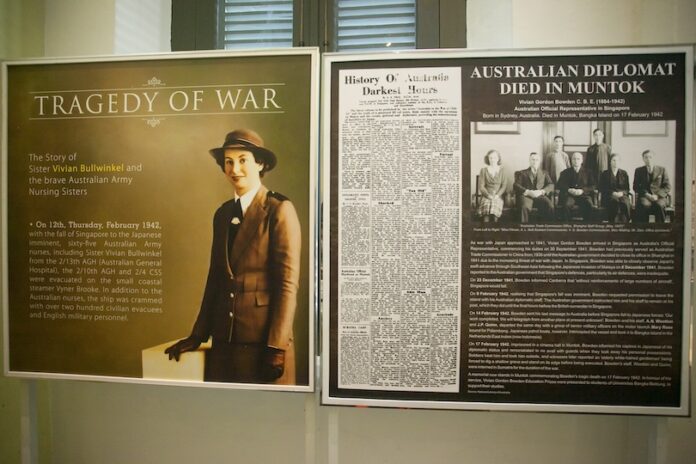The art of clothing involves a clever deception, highlighting and concealing aspects of the wearer’s body. Similarly, Vivian Bullwinkel’s dress at the Australian War Memorial (AWM) tells a story of revelation and concealment. Bullwinkel, an Australian Army nurse, wore this dress during the Banka Island massacre in 1942, where Japanese soldiers killed 22 captured nurses. Bullwinkel survived, returning to Australia with the dress largely intact except for two bullet holes and missing buttons. Today, the dress is part of the AWM’s World War Two artefacts exhibition, accompanied by an information panel about the attack. However, some crucial details are left out.
This essay explores the display of Bullwinkel’s dress as a reflection of the silences surrounding sexual assaults in war memorialisation. It proceeds in two sections, examining the meanings conveyed by the display versus the omissions uncovered by historians. The contrast serves as a catalyst to delve into the forces behind the silences on sexual assault in war memorialisation. Ultimately, the AWM’s display of Bullwinkel’s dress symbolizes the disparity between wartime experiences and their commemorative representations, offering a unique insight into war and its memorialisation.
Revealing and Concealing Meaning
The dress itself portrays a neat and orderly appearance, combining practicality with elegance. It evokes a sense of sturdy femininity suitable for serious work, complemented by decorative elements. The length suggests modesty, with a subtle Red Cross emblem stitched on one sleeve. Despite bearing two bullet holes and missing buttons, the dress maintains a composed and dignified appearance, hinting at the noble purpose of healing it symbolizes. The display of the dress alongside the violent history of the massacre creates a poignant juxtaposition, inviting viewers to feel inspired by Bullwinkel’s courage in the face of horror.
However, claims by academics, historians, and journalists suggest a different narrative. They argue that Bullwinkel and her fellow nurses may have been subjected to sexual assault by the Japanese soldiers before being killed. Detailed examinations of the dress reveal inconsistencies that challenge the pristine image presented in the exhibition. These revelations reshape the story, painting a darker and more disconcerting picture of the dress’s history.
Silencing Sexual Assault in War Memorialisation
War memorials often overlook or downplay representations of sexual and gender-based violence, creating a significant gap in acknowledging these atrocities. The reasons for this omission are complex, involving societal attitudes, victim agency, and state interests in shaping historical narratives. Victims of sexual assault may choose to remain silent due to stigma, trauma, or concerns about upsetting family members of other victims. States may also suppress stories of wartime rape to maintain a certain national image or avoid disturbing public opinion about war.
The absence of sexual assault in war memorialisation has far-reaching consequences, depriving the public of crucial narratives and perpetuating a selective view of history. While silence can be a form of agency for survivors, it also reflects broader societal forces that dictate what stories are worthy of remembrance. Acknowledging and addressing these silenced narratives is vital for a more comprehensive and truthful understanding of war and its impact on individuals.
Conclusion
The story of Bullwinkel’s dress encapsulates the complexities of wartime experiences and their memorialisation. The garment, preserved in glass, serves as a symbol of the gap between historical events and their commemorative representations. As we navigate the uncertainties and silences surrounding Bullwinkel’s ordeal, we are reminded of the enduring legacy of war and the challenges of honoring and acknowledging the full spectrum of wartime experiences.
Notes
References:
For further reading, explore additional resources on E-International Relations.




